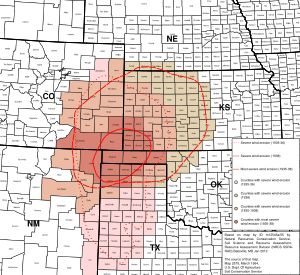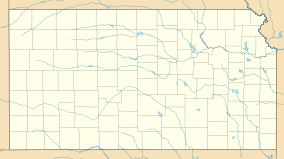Cimarron National Grassland facts for kids
Quick facts for kids Cimarron National Grassland |
|
|---|---|

Plant cover on sandy soils of the Cimarron National Grassland.
|
|
| Location | Elkhart, Kansas, Kansas, United States |
| Area | 108,176 acres (437.77 km2) |
| Elevation | 1,033 m (3,389 ft) |
| Established | United States National Grassland |
| Operator | U.S. Forest Service, Kansas Department of Wildlife, Parks and Tourism |
The Cimarron National Grassland is a special protected area in Morton County, Kansas, United States. It's a huge area of public land, meaning it belongs to everyone! A tiny part of it even stretches into Stevens County.
This grassland is managed by the U.S. Forest Service. It's looked after along with the Pike and San Isabel National Forests and the Comanche National Grassland in Colorado. You can find local offices in Elkhart, Kansas.
Contents
Exploring the Cimarron Grassland's Geography
The Cimarron National Grassland covers about 108,176 acres (43,777 hectares). That's a lot of land! It's part of the Great Plains, a huge flat area in the middle of North America. The Cimarron River flows right through it.
Land and Plants
The land here is mostly flat. It gently slopes downwards from west to east. But watch out for bluffs, which are like small cliffs, rising about 100 feet (30 meters) above the river valley. Most of the plants you'll see are shortgrass prairie grasses. In some salty areas, you'll find lots of sand sagebrush. Near the river, there are groves of cottonwood trees and other types of trees.
Weather and Seasons
The climate in the Cimarron National Grassland is called "semi-arid." This means it doesn't get a lot of rain, only about 18 inches (457 mm) each year. Most of the rain falls in the summer. It can also get very windy, which dries out the soil even more.
Summers are hot! In July, the average high temperature is about 93°F (34°C), and the average low is 64°F (18°C). Winters are cold. In January, the average high is 45°F (7°C), and the average low is 18°F (-8°C). Temperatures can be extreme, from a scorching 110°F (43°C) to a freezing -22°F (-30°C)!
The Cimarron River and Point of Rocks
The Cimarron River runs through the grassland. From late summer through winter, the river often looks dry on the surface. But don't worry, lots of green plants still grow along its banks! There's a special spot called Middle Spring that flows all year round. Beavers have even built dams there, creating cool pools of water.
Point of Rocks is a big rock formation that overlooks the Cimarron River valley. It was a very important landmark for early travelers on the Santa Fe Trail. Ranchers today also find it useful because many springs are in that area. Point of Rocks is about 3,540 feet (1,079 meters) high.
History of the Grassland

Long ago, the land that is now Cimarron National Grassland was home to the Comanche people and other Native American tribes.
The Santa Fe Trail
In 1822, a man named William Becknell was the first to travel the Santa Fe Trail with wagons. He created a different path called the Cimarron Cutoff, which went right through what is now the National Grassland. Middle Spring was super important because it was one of only three reliable water sources along a long 150-mile (241 km) stretch of the trail. Sadly, in 1831, a famous mountain man named Jedediah Smith was killed by Comanches near the Grassland.
From Ranches to Dust Bowl to Grassland
In 1879, the Beaty Brothers started the first ranch in the area, called Point of Rocks Ranch. Later, wheat farmers moved in. They did well during years with good rain. However, a terrible drought in the 1930s led to the infamous Dust Bowl. Morton County, Kansas was one of the worst-hit places in the entire country.
The U.S. government bought land from farmers who had lost everything. They worked to restore the original prairie grasses. In 1960, the Cimarron National Grassland was officially created. Today, the grassland is used for many things. These include protecting water, helping wildlife, offering recreation, allowing cattle to graze, and even producing oil and gas.
Recent Events: The Tunner Fire
In May 2011, a big wildfire called the Tunner Fire burned about half of the park. It also burned thousands of acres of private land and the campground. But don't worry! Heavy rains in the spring of 2012 helped the land recover. The area became green again, and many parts of the park were reopened.
Fun Things to Do at Cimarron National Grassland
The Cimarron National Grassland offers many ways to have fun outdoors! Most of the recreation spots are about 7 miles (11 km) north of Elkhart, off Highway 27.
Activities Galore!
You can enjoy activities like:
- Camping
- Hiking
- Horseback riding
- Fishing
- Hunting
- Taking a car tour
Trails to Explore
The grassland has 23 miles (37 km) of the Santa Fe National Historic Trail. You can still see the ruts left by old wagon trains! There's also a mowed path, called a companion trail, that runs alongside the Santa Fe Trail for 19 miles (31 km). If you like walking through trees, the Turkey Trail is 10.5 miles (17 km) long and goes through the wooded area along the Cimarron River.
Camping and Fishing
The Cimarron Recreation Area is a great place to camp. You can set up tents or bring a trailer. It also has picnic spots and a group site. Plus, it gives you access to the Turkey Trail.
There are several fishing ponds, including four at the Cimarron Recreation Area. These ponds are stocked with rainbow trout in the winter. In the summer, they have channel catfish. You might also catch crappie, sunfish, and largemouth bass.
Hunting and Wildlife Watching
If you enjoy hunting, you might find whitetail deer, pronghorn, prairie chicken, quail, pheasant, prairie dogs, and jack rabbits.
The Cimarron Grassland is home to a rare bird called the lesser prairie chicken. There are two special spots where you can watch them. The male birds do their amazing courting dances from mid-March to early June. Elk were brought back to the Grassland in 1981, and there's a herd of about 50 now. Sometimes, special permits are given for hunting to help manage the herd size.
Scenic Car Tour
You can take a car tour of about 30 miles (48 km) on mostly dirt roads. This tour will lead you to many interesting places in the Grassland. You can see a prairie dog town, visit Point of Rocks, and explore parts of the historic Santa Fe Trail.



